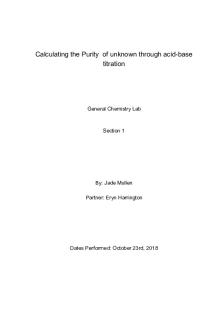Benzilic Acid from benzene lab report PDF

| Title | Benzilic Acid from benzene lab report |
|---|---|
| Author | Ugwu Somkene |
| Course | Organic Chemistry 2 |
| Institution | Lewis University |
| Pages | 4 |
| File Size | 244 KB |
| File Type | |
| Total Downloads | 76 |
| Total Views | 157 |
Summary
Download Benzilic Acid from benzene lab report PDF
Description
Benzilic Acid from benzene Purpose Convert Benzil to Benzilic Acid, as the second step of the Multi-step Synthesis. This experiment is the second part of the multi-step synthesis of benzilic acid, which started in the previous experiment 7 with the conversion of benzoin to benzil and continues in experiment 8 with the transformation of benzil to benzilic acid. Reaction and Mechanism
Experiment Set-up
Procedure Doubled the scale: used 0.200g benzil. Heating the reaction mixture to 90-100 ℃
, dissolved
in 10 minutes. Obtained yellow solution. Started addition of 32% aqueous solution of KOH, then boiled to 110 ℃ (block), stirring for 15 minutes. Change in color from yellow to brown, the to dark purple, then back to brown. Transfer reactions mix into a 50ml beaker, cooled in ice bath for 10 minutes, crystals were formed. Added 3ml cold ethanol, to facilitate the transfer of solid product into Buchner funnel. Solid was dark brown, was washed with 3x1ml cold ethanol; solid product became light brown. Solid product was kept under the vacuum for 5-10 minutes. Solid (potassium benzilate) was transferred to a flask with 2ml hot water (70 ℃ ). Solid was completely dissolved, and with swirling, added 1ml of 1M Hcl. (dropwise), With pH monitoring, pH dropped from 14 to 1.5, a white solid was formed. Kept in ice bath for 5 minutes. Crystals were washed with about 3ml ice-cold ethanol, then transferred to a Buchner funnel. Kept under vacuum for 20 minutes, obtained light tan crystals. Melting point was determined to be 145.2 ℃−¿ 147.9 ℃ . Comparison with literature value of 150 ℃ . According to Wikipedia, https://en.wikipedia.org/wiki/Benzilic_acid the melting point of benzilic acid is between 150 ℃−¿ 152 ℃ . Experimental Observations Maintain times, color changes, etc. Change in color from yellow to brown, the to dark purple, then back to brown. Results and Calculations Mass of product= 0.069g Theoretical yield=
mass Benzil MW benzil
x MW product =
0.2000 g 2 10.28 g/mol
x 228.24g/mol =0.217g
% yield=
mass product theoretical yield
X 100 =
0.069 g 0.217 g
X 100 = 31.8%
IR Spectrum of Benzilic Acid
C=C 0-H
C-H C=O
O-H is a weak intensity, frequency of 2900. C=O is a strong intensity, frequency of 1700. C=C has a frequency of 1400. C-H is a strong intensity, frequency of 700-1000. Discussion
In the first step alcohol group of benzoin is oxidized to ketone group forming benzil in presence of concentrated nitric acid. In the second step on treatment with hydroxide ion molecular rearrangement occurs to 1,2-diketone. According to Wikipedia, https://en.wikipedia.org/wiki/Benzilic_acid the melting point of benzilic acid is between 150 ℃−¿ 152 ℃ . The driving force for the reaction is provided by the formation of
potassium benzilate. Once this salt is produced, acidification yields benzilic acid. The reaction can generally be used to convert aromatic α-hydroxy acids. Other compounds, however, also will undergo benzilic acid type of rearrangement. Benzilic acid is used in the manufacture of pharmaceuticals, used in the manufacture of the incapacitating agents 3-quiuclidinyl. An improvement
Conclusion The process for the rearrangement of substituted benzil to benzilic acid is performed in the presence of sodium or potassium hydroxide as a base using ethanol-ether as a medium. The reaction requires reflux temperature for complete conversion. However, these bases containing metallic ions and generate metallic containing effluent waste which may require additional expenditure for treatment. This experiment was successful as the second step of the multi-step process to produce benzilic acid was achieved....
Similar Free PDFs

Acid Ionization Lab Report
- 8 Pages

Acid base titration lab report
- 5 Pages

Acid-Base Titration Lab Report
- 7 Pages

Benzoic acid lab report 1
- 7 Pages

Adipic acid from cyclohexanone
- 5 Pages
Popular Institutions
- Tinajero National High School - Annex
- Politeknik Caltex Riau
- Yokohama City University
- SGT University
- University of Al-Qadisiyah
- Divine Word College of Vigan
- Techniek College Rotterdam
- Universidade de Santiago
- Universiti Teknologi MARA Cawangan Johor Kampus Pasir Gudang
- Poltekkes Kemenkes Yogyakarta
- Baguio City National High School
- Colegio san marcos
- preparatoria uno
- Centro de Bachillerato Tecnológico Industrial y de Servicios No. 107
- Dalian Maritime University
- Quang Trung Secondary School
- Colegio Tecnológico en Informática
- Corporación Regional de Educación Superior
- Grupo CEDVA
- Dar Al Uloom University
- Centro de Estudios Preuniversitarios de la Universidad Nacional de Ingeniería
- 上智大学
- Aakash International School, Nuna Majara
- San Felipe Neri Catholic School
- Kang Chiao International School - New Taipei City
- Misamis Occidental National High School
- Institución Educativa Escuela Normal Juan Ladrilleros
- Kolehiyo ng Pantukan
- Batanes State College
- Instituto Continental
- Sekolah Menengah Kejuruan Kesehatan Kaltara (Tarakan)
- Colegio de La Inmaculada Concepcion - Cebu










